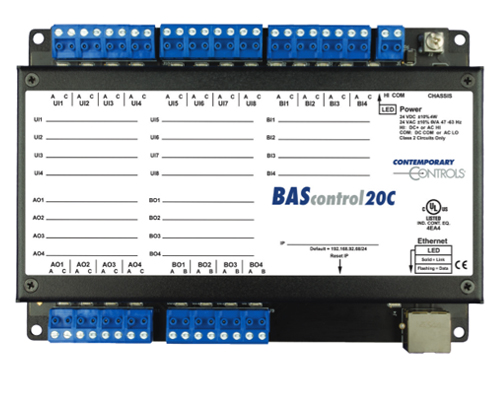BAScontrol20C 20-point BACnet/IP Client Sedona Unitary Controller

Support Materials
Data Sheet
Additional Resources
BACnet Client Instruction Sheet
Sedona Open Control Reference Manual
BAScontrol Toolset Quick Start Guide
BAScontrol Toolset User Manual
Learn More about Open Controllers
Presentation: BAScontrol Series of BACnet/IP Controllers: Using Sedona to Create an Open Controller
Regulatory Compliance
North American Safety Standards Certificate, (UL 508), (CSA-C22.2 No. 142)
Product Overview
Most BACnet devices are BACnet servers which do not initiate requests to other devices other than an initial "I-Am" request when first joining the network. BACnet client devices do initiate requests and expect BACnet servers to respond to requests and data is exchanged. The BAScontrol20C is a BACnet/IP server and also provides BACnet/IP client capability which allows the user to read and/or write points served up by devices on the BACnet internetwork. The BAScontrol20C is a 20-point unitary controller which supports BACnet/IP and Sedona using a direct Ethernet connection. The controller complies with the B-ASC device profile having a convenient mix of 8 universal inputs, 4 binary inputs, 4 analog outputs and 4 relay outputs. Unique to the unit are 48 web components which link Sedona wire sheet readable/writeable data to web pages, and 24 virtual points which link Sedona wire sheet readable/writeable data to a BACnet client.
The device is fully web page-configurable, and freely programmable using Sedona's drag-and-drop programming methodology of assembling components onto a wire sheet to create applications. The unit can be programmed using Niagara Workbench AX or a third-party Sedona programming tool such as Sedona Application Editor (SAE). Rugged design, low profile, and wide temperature operation make it suitable for indoor or outdoor use.
Versatile Control Device — Unitary controller or remote Ethernet I/O
- BACnet/IP compliant with a B-ASC device profile
- Resident BACnet Client can read/write BACnet objects
- Resident Sedona Virtual Machine (SVM)
- Programmable via Workbench AX or Sedona Editor
- Configurable with a common web browser
- Direct connection to Ethernet network
- NTP or manually-settable real-time clock
- COV subscriptions – 14 binary and 2 analog
- Wide operating temperature range of -40°C to +75°C
Flexible Input/Output — 20-points of physical I/O
- Eight configurable universal inputs:
Thermistor, resistance, analog voltage, binary input, pulse inputs (4 max) - Four contact closure inputs
- Four analog voltage outputs
- Four relay outputs
Product Details
The BAScontrol20C utilizes a powerful 32-bit ARM7 processor with 512 kB of flash memory plus a 16 Mbit serial flash file system for storing configuration data and an application program.
By operating at the BACnet/IP level, the BAScontrol20C can share the same Ethernet network with supervisory controllers and operator workstations. The unit can be configured for a fixed IP address or can operate as a DHCP client receiving its IP address from a DHCP server. A real-time clock with a supercap backup allows for creating local schedules.
A 10/100 Mbps Ethernet port supports protocols such as BACnet/IP, Sedona SOX, HTTP and FTP. Configuration of universal inputs and virtual points can be accomplished using web pages. Type II and type III 10 kΩ thermistor curves and a 20 kΩ thermistor curve are resident in the unit. Current inputs can be measured using external resistors. Contact closures require a voltage-free source. Binary inputs and outputs as well as analog outputs require no configuration. The unit is powered from either a 24VAC/VDC source.
BACnet servers serve up their points to BACnet clients. Writable BACnet server device points can also be written to by BACnet clients. The BAScontrol20C is capable of directly reading from and writing to BACnet/IP devices on the network connected to one of its Ethernet ports by the use of NetV (Network Variable) Sedona components. NetV components allow the BAScontrol20C to read and/or write Analog Input (AI), Binary Input (BI), Analog Value (AV), Binary Value (BV), Analog Output (AO), and Binary Output (BO) BACnet object types in its wire sheet. In addition, with a BACnet router in place (such as BASRT-B or BASRTSX-B), the BAScontrol20C is capable of reading from and/or writing to BACnet MS/TP devices which are being routed to BACnet/IP. The points obtained over the BACnet network can be used in the BAScontrol20C's Sedona wire sheet application logic, become scaled, calculated, and/or converted to different data types, written to other BACnet devices, served up to BACnet supervisory controllers and operator workstations by using Virtual Components, as well as be monitored, displayed, or exposed for configuration on BAScontrol20C's web page by the use of Web Components.
Ordering Information
Please contact your regional office for replacement options.